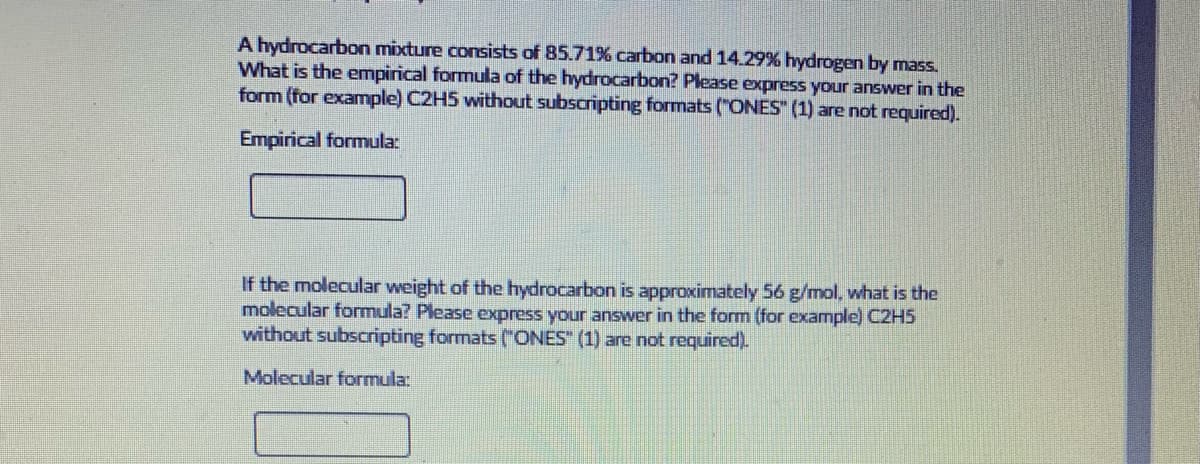A hydrocarbon mixture consists of 85.71% carbon and 14.29% hydrogen by mass. What is the empirical formula of the hydrocarbon? Please express your answer in the form (for example) C2H5 without subscripting formats ("ONES" (1) are not required). Empirical formula: If the molecular weight of the hydrocarbon is approximately 56 g/mol, what is the molecular formula? Please express your answer in the form (for example) C2H5 without subscripting formats ("ONES" (1) are not required). Molecular formula:
A hydrocarbon mixture consists of 85.71% carbon and 14.29% hydrogen by mass. What is the empirical formula of the hydrocarbon? Please express your answer in the form (for example) C2H5 without subscripting formats ("ONES" (1) are not required). Empirical formula: If the molecular weight of the hydrocarbon is approximately 56 g/mol, what is the molecular formula? Please express your answer in the form (for example) C2H5 without subscripting formats ("ONES" (1) are not required). Molecular formula:
Chemistry & Chemical Reactivity
10th Edition
ISBN:9781337399074
Author:John C. Kotz, Paul M. Treichel, John Townsend, David Treichel
Publisher:John C. Kotz, Paul M. Treichel, John Townsend, David Treichel
Chapter2: Atoms Molecules And Ions
Section2.8: Instrumental Analysis: Determining Compound Formulas
Problem 2.2ACP: Salvarsan was long thought to be a single substance. Recently, however, a mass spectrometry study of...
Related questions
Question

Transcribed Image Text:A hydrocarbon mixture consists of 85.71% carbon and 14.29% hydrogen by mass.
What is the empirical formula of the hydrocarbon? Please express your answer in the
form (for example) C2H5 without subscripting formats ("ONES" (1) are not required).
Empirical formula:
If the molecular weight of the hydrocarbon is approximately 56 g/mol, what is the
molecular formula? Please express your answer in the form (for example) C2H5
without subscripting formats ("ONES" (1) are not required).
Molecular formula:
Expert Solution
This question has been solved!
Explore an expertly crafted, step-by-step solution for a thorough understanding of key concepts.
This is a popular solution!
Trending now
This is a popular solution!
Step by step
Solved in 4 steps

Knowledge Booster
Learn more about
Need a deep-dive on the concept behind this application? Look no further. Learn more about this topic, chemistry and related others by exploring similar questions and additional content below.Recommended textbooks for you

Chemistry & Chemical Reactivity
Chemistry
ISBN:
9781337399074
Author:
John C. Kotz, Paul M. Treichel, John Townsend, David Treichel
Publisher:
Cengage Learning

World of Chemistry
Chemistry
ISBN:
9780618562763
Author:
Steven S. Zumdahl
Publisher:
Houghton Mifflin College Div

World of Chemistry, 3rd edition
Chemistry
ISBN:
9781133109655
Author:
Steven S. Zumdahl, Susan L. Zumdahl, Donald J. DeCoste
Publisher:
Brooks / Cole / Cengage Learning

Chemistry & Chemical Reactivity
Chemistry
ISBN:
9781337399074
Author:
John C. Kotz, Paul M. Treichel, John Townsend, David Treichel
Publisher:
Cengage Learning

World of Chemistry
Chemistry
ISBN:
9780618562763
Author:
Steven S. Zumdahl
Publisher:
Houghton Mifflin College Div

World of Chemistry, 3rd edition
Chemistry
ISBN:
9781133109655
Author:
Steven S. Zumdahl, Susan L. Zumdahl, Donald J. DeCoste
Publisher:
Brooks / Cole / Cengage Learning

Chemistry: An Atoms First Approach
Chemistry
ISBN:
9781305079243
Author:
Steven S. Zumdahl, Susan A. Zumdahl
Publisher:
Cengage Learning

Chemistry
Chemistry
ISBN:
9781305957404
Author:
Steven S. Zumdahl, Susan A. Zumdahl, Donald J. DeCoste
Publisher:
Cengage Learning
